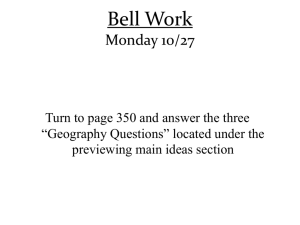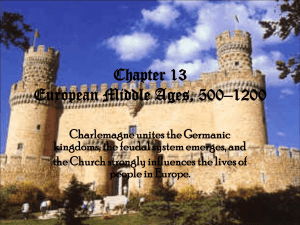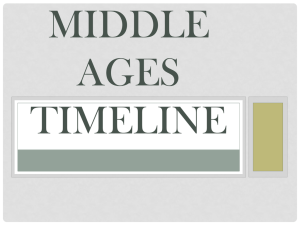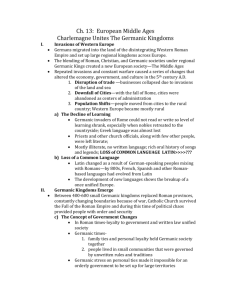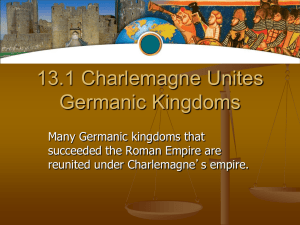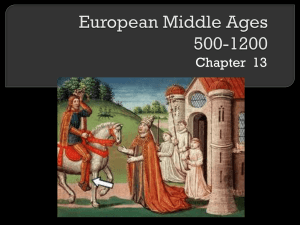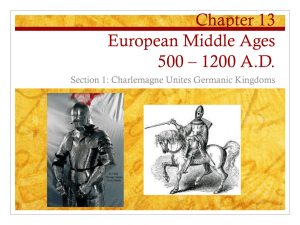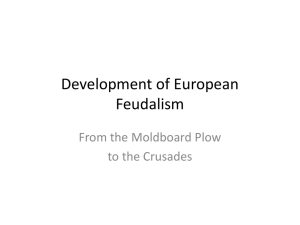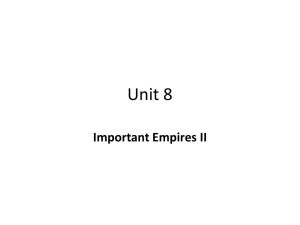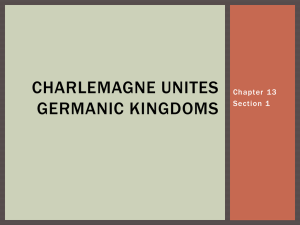Chapter 13-European Middle Ages
advertisement
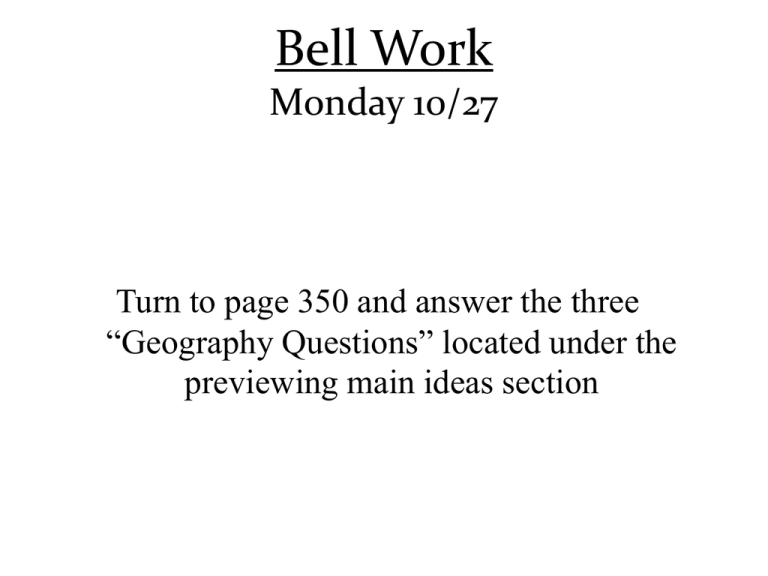
Bell Work Monday 10/27 Turn to page 350 and answer the three “Geography Questions” located under the previewing main ideas section European Middle Ages Chapter 13 Section 1-Charlemagne Unites Germanic Kingdoms Invasion of Western Europe • Middle Ages- Spanned 5001500 A.D. • Disruption of Trade– Merchants faced invasion from land and sea. Devastated Europe’s economy and left money scarce • Downfall of Cities– Cities became abandoned as centers of administration Invasion of Western Europe • Population Shifts– Cities collapsed = nobles and other citizens retreating to rural areas. • Decline of Learning– Germanic invaders couldn’t read or write so as result education decreased. • No written language but strong oral tradition – Greek language was nearly lost Invasion of Western Europe • Loss of Common Language– Pure Latin (although still the official language) was lost. – By the 800’s the language spoken was a mix of Latin, French, Spanish, and otherRoman languages Germanic Kingdoms Emerge • Between 400-600 small Germanic kingdoms replaced Roman provinces • Changes in Government– Personal loyalty and family ties held Germanic society together – Germanic people lived in small communities with unwritten rules and traditions Germanic Kingdoms Emerge • Germanic Warriors– Pledged their loyalty to the chief – Would fight to the death for their lord – Saw it as disgrace to outlive the lord – Felt no obligation to a king – Would not pay taxes or obey a emperor they never met Germanic Kingdoms Emerge • Clovis Rules the Franks– Clovis was the leader of the Franks • Brought Christianity to the region • Church of Rome supported him • By 511, Clovis had unified the Franks into one united kingdom Germans Adopt Christianity • Politics played a key role in spreading Christianity. • By 600 The Church and Franks converted many Germanic people • Religious travelers often risked their lives bringing religious beliefs to other lands • Monasteries– Religious communities built by the Church • Asked men to give up their possession and serve God • Nuns-Women who served God – Lived in convents Germans Adopt Christianity • Benedict– Italian monk who wrote rules for living in a monasteries • Scholastica– Benedict’s sister – Adopted his rules for women living in convents Germans Adopt Christianity • Monks and nuns– Devoted their lives to prayer and good works – Opened schools – Maintained libraries – Copied books • Illuminated Manuscripts– Beautiful religious writings decorated with ornate pictures Germans Adopt Christianity • 590-Gregory I becomes pope – Under him the office of the pope expands – Becomes secular (worldly) now involved in politics • Used Church Funds to– Raise an army – Repair roads – Help the poor An Empire Evolves • Roman empire dissolved – Small kingdoms sprang up – England split into 7 kingdoms – Gaul-Largest of the kingdoms • Controlled by the Franks An Empire Evolves • Charles Martel Emerges– Major Domo-Mayor of the palace • Most powerful person in the Frankish kingdom – 719-Charles Martel becomes major domo • Nicknamed Charles “The Hammer” • Extended the Franks reign North, South and East • 732-Battle of Tours- Defeated Muslim raiders in Spain – Carolingian Dynasty-Ruled the Franks from 751 to 987 Charlemagne Becomes Empire • Charlemagne– Charles “The Great” – Ruled the Franks from 771 to 813 – Tall man 6’4” Charlemagne Becomes Empire • Charlemagne Extends the Franks Rule – Ruled the greatest empire since Rome – Conquered new lands to the south and east – Spread Christianity – Most powerful King in Western Europe – 800-Pope Leo III crowns him “Roman Emperor” • Joined Germanic power and the Church Charlemagne Becomes Empire • 813-Charlemagne crowns his son Louis “The Pious” emperor – Louis “The Pious” • Very Religious Man • Ineffective ruler – Louis’ three sons • Lothair, Charles the Bald, Louis the German – Treaty of Verdun • Divided Louis’ Kingdom among his three sons Bell Work Thursday 10/30 Look in your book beginning on page 358 and begin reading to find the answers • 1.) What group invaded Europe in the 800’s? • 2.) What would a lord give a vassal in exchange for military protection? • 3.) What shape does the structure of Feudal Society look like? Learning Targets Chapter 13: Fotrmation of Western Europe • Learning Objective 2: Task 2 (10/30) • To learn this I will be able to…demonstrate my understanding of the structure/social classes located with the feudal system by diagramming the roles and responsibilities through creating guided notes Section 2-Feudalism in Europe Invaders Attack Western Europe • Vikings Invade from the North – Sailed from Scandinavia – Known as Northmen or Norsemen – Carried out their raids with swords and heavy wood shields – Largest Viking ships carried 300 men Invaders Attack Western Europe • Vikings Invade from the North (continued) – Acted as warriors, traders, farmers and explorers – Leif Ericson • Viking explorer who reached North America 500 years before Columbus – Vikings began accepting Christianity Invaders Attack Western Europe • Magyars and Muslims Attack from the East and South – Magyars • Nomadic people from Hungary • Invaded from the east on horseback around 800 • Attacked villages and monasteries • Took captives as slaves Invaders Attack Western Europe • Magyars and Muslims Attack from the East and South – Muslims • Struck from the south • Originally wanted to settle Europe, later decided to plunder (rob people) as well – As a result of Magyar and Muslim attacks people began to look for protection from local rulers A New Social Order: Feudalism • Feudal System-A system of governing landholding based on rights and obligation – Lord-Land Owner – Fief-Land grant in exchange for military protection – Vassal-Person receiving the fief A New Social Order: Feudalism • The Feudal Pyramid- A New Social Order: Feudalism • Social Classes– Three Groups • Those who fought (knights, nobles) • Those who prayed (Priests, Nuns ect.) • Those who worked (peasants) – Serfs-People who could not lawfully leave where they were born Manors: The Economic Side of Feudalism • Manor-The Lords Estate – Lord would provide serfs with land and protection – Serfs would work the land and maintain the estate • Owed 2-3 days of work and a portion of their grain Manors: The Economic Side of Feudalism • Peasants on the manor– Rarely traveled more than 25 miles from the manor – 15-30 families lived on the manor – Produced crops, milk, cheese, fuel, cloth, leather goods and lumber – Purchased salt, iron and millstones (used for grinding grain) • Tithe-Church tax (10% of income) • Also paid grain and marriage tax Bell Work Monday 11/03 Look in your book beginning on page 358 and begin reading to find the answers • 1.) What were the three social classes of the feudal system? • 2.) What was unique about the average serfs living arrangements? • 3.) What was a tithe and who received it? Bell Work Wednesday 11/05 Look in your book beginning on page 358 and begin reading to find the answers • 1.) How were the Vikings different from earlier Germanic groups that invaded Europe? • 2.) How was a manor militarily and economically sufficient during the Middle Ages? • 3.) What advantages did a medieval manor provide to the serfs living on it? Bell Work Thursday 11/06 Look in your guided notes for Chapter 13 Section 1 and 2 to find the answers • 1.) What role did Benedict and Scholastica play in strengthening religious communities? • 2.) After becoming Pope in 590 A.D. what did Gregory I use church funds to accomplish? • 3.) What type of weapons did Vikings tend to carry with them on their conquests of Europe? Bell Work Friday 11/07 Look in your book beginning on page 364 to find the answers • 1.) Why was it important for young boys to leave home and become knights? • 2. Who normally lived inside of a medieval castle? • 3. What were some of the themes of medieval literature? Section 3-The Age of Chivalry Knights: Warriors on Horseback • Technology of Warfare Changes– Leather saddles and stirrups allowed warriors to handle heavy weapons while fighting – Mounted knights = most important part of the army Knights: Warriors on Horseback • A Warriors Role– Feudal lords hired private armies of knights to protect their land • 40 days of service a year – Traded protection for fiefs (land grants) • Wealth allowed the knights to – Devote their lives to war – Buy weapons, armor, warhorses Knighthood and the Code of Chivalry • Chivalry-A complex set of ideals, in which a knight would fight bravely for three masters – Earthly feudal lord – Heavenly Lord – His chosen lady • Qualities of an Ideal Knight– Loyal – Brave – Courteous Chivalry The Italian painter Paolo Uccello captures the spirit of the age of chivalry in this painting, St. George and the Dragon (c. 1455–1460). According to myth, St. George rescues a captive princess by killing her captor, a dragon. • The Knight St. George, mounted on a horse and dressed in armor, uses his lance to attack the dragon. • The Dragon The fierce looking dragon represents evil. • The Princess The princess remains out of the action as her knight fights the dragon on her behalf. SKILLBUILDER: Interpreting Visual Sources In what way does this painting show the knights commitment to the code of chivalry ? Knighthood and the Code of Chivalry • Knights Training– Age 7-Sent off to a castle became a page – Age 14- Became a squire (knights servant) – Age 21-Became a fullfledged knight • Tournaments-Staged battles for practice Literature of Chivalry • Epic Poems– They recounted a hero’s deeds and adventures – Song of Roland-Earliest and most famous epic poem • Troubadours-Traveling Poet-Musicians – Composed poems about the joys and sorrows of love Women’s Role in Feudal Society • Women were seen as inferior to men • Noblewomen– Could inherit and estate from her husband – Send knights to war – Act as military commander when her husband was away • Hurled rocks and shot arrows at attackers – They were most often limited to activities around the home or convent Women’s Role in Feudal Society • Peasant Women– Poor and powerless – Performed endless labor • In the home and fields • Raised children • Took care of families – Poor girls learned house hold skills – Rich girls were educated Bell Work Monday 11/10 Look in your book beginning on page 370 to find the answers • 1.) What were some of the matters covered under canon law? • 2.) How did Otto the Great make the crown stronger than the German nobles? • 3.) Why did lay investiture cause problems between kings and popes? Daily ObjectiveContent Objective: • SWD analysis of the structure of the Catholic Church and its sphere of influence within the feudal system by categorizing the roles and responsibilities of the emperor and the pope through the use of student led guided notes • SWD application of information regarding important political/historical figures, events and evidentiary text located in Chapter 13 Section 2 through compiling information designed to answer guided section questions Language Objective: • Students will read and record information regarding the structure of the Catholic Church and its sphere of influence within the feudal system by categorizing the roles and responsibilities of the emperor and the pope through filling in teacher led guided notes • Students will write answers to guided questions that require examination of the additional supporting resources/information located within Chapter 13 by completing guided section questions Section 4-The Power of the Church The Far Reaching Authority of the Church • Conflict between Church and State – Pope Gelasius realized that a conflict could arise between the church and the state. – He suggested that if the emperor and pope ruled their own areas they could share power Structure of the Catholic Church The Far Reaching Authority of the Church • Religion as a Unifying Force – Feudalism and the manor system divided people – The Church brought them together • Sacraments-Important religious ceremonies designed to help Christians achieve salvation – Ex. Baptism = entrance into the Christian community • Canon Law-Church law governing marriage and other religious matters The Church and The Holy Roman Empire • Otto I Allies with the Church – 936-Otto “The Great” is crowned king of Germany • Followed Charlemagne’s example and formed a close alliance with the church • Used the Church to help limit the power of nobles • Invaded Italy on behalf of the pope • As a reward he was crowned emperor by the pope in 962 A.D. The Church and The Holy Roman Empire • Holy Roman Empire–German-Italian empire that became the strongest state in Europe The Emperor Clashes with the Pope • Lay Investiture –A ceremony in which kings and nobles appointed church officials • 1075-Pope Gregory VII banned Lay Investiture • Concordant of Worms-Compromise in which the Church alone could name bishops but the Emperor could veto the selection Disorder in the Empire • 1152-Fredrick I was named German king – Nicknamed “Barbarossa” for his red beard – 1st person to call his land the Holy Roman Empire – Attacked wealthy Italian cities • Italian merchants united against him in an attempt to remove him from power Disorder in the Empire • 1176-Soldiers in the Lombard League faced off against Fredrick’s army at the Battle of Legnano – For the 1st time in history merchants (or anyone for that matter) used cross bows to defeat feudal knights – This humiliating defeat destroyed his influence over German princes
